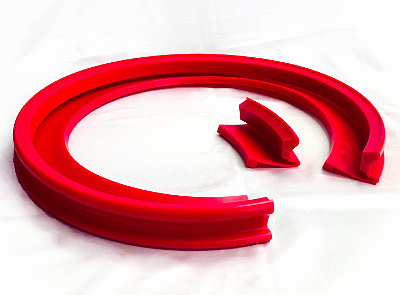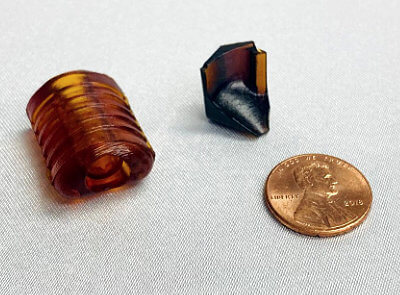Liquid injection molding (LIM) is similar to urethane injection molding, but instead of melting and cooling pellets, the liquid is directly injected into a mold cavity and allowed to react in the mold, resulting in parts with superior physical properties. The thermoset material produces parts with better performance than traditional injection molded parts.
LIM is best suited to larger pieces with thin cross-sections. The technique offers lower possibilities of air entrapment combined with large sizes (up to 10’ long and 30” in diameter). In addition to large sizes which are difficult to produce in injection molding, variable cross-sections can also be made. The increase in pressure during the molding process allows for finer details than with traditional open casting. Small production runs are also possible with LIM.


Liquid Injection Molding:
Taking Injection Molding to the Next Level
When it comes to manufacturing durable and high-performing parts, LIM takes center stage. Similar to its counterpart, urethane injection molding, LIM revolutionizes the process by directly injecting liquid into a mold cavity. This not only eliminates the need to melt and cool pellets but also allows the material to react in the mold itself, resulting in parts with superior physical properties.
Achieving Peak Performance
One of the significant advantages of liquid injection molding is its ability to produce parts with better performance than traditional injection molded parts. The thermoset material used in LIM ensures that the final product boasts exceptional strength, durability, and chemical resistance. Whether you need parts for industrial equipment or automotive applications, LIM can deliver outstanding results that meet your performance requirements.
Perfect for Large Pieces with Thin Cross-Sections
Liquid injection molding truly shines when it comes to larger pieces with thin cross-sections. The technique excels at creating components that are both substantial in size and boast a slender design. With LIM, you can manufacture parts up to an impressive 10 feet long and 30 inches in diameter. This opens up a new realm of possibilities for industries requiring large-scale components.
No Room for Air Entrapment
Air entrapment can be an issue in traditional injection molding processes. However, LIM offers a solution to this problem by significantly reducing the chances of air entrapment occurring during production. With LIM, you can rest assured knowing that your final products will be free from any unwanted air pockets or voids that could compromise their structural integrity.
Embrace Variation with Variable Cross-Sections
In addition to tackling large sizes, liquid injection molding also allows for variable cross-sections. This means that you can create parts with intricate designs and shapes that were once difficult or impossible to achieve with traditional molding methods. The increase in pressure during the molding process enables LIM to produce finer details, opening up a whole new world of possibilities for your designs.
No Job is Too Small with LIM
Whether you're looking to manufacture parts in high volumes or require small production runs, liquid injection molding has got you covered. Unlike other manufacturing processes, LIM is versatile enough to accommodate large-scale and low-volume production requirements. Whether you need thousands of parts or just a few, LIM can cater to your needs without compromising on quality.


Advantages vs. Disadvantages
Liquid injection molding offers a game-changing approach to injection molding. With its ability to produce parts with superior physical properties and tackle large sizes and variable cross-sections, LIM takes manufacturing to a whole new level. If you're looking to create durable and high-performing parts, it's time to consider LIM as your go-to solution. Say goodbye to the limitations of traditional molding methods and embrace the endless possibilities that LIM brings. In most durometers, all of Pleiger’s compounds can be LIM, allowing for material optimization. Custom colors are also possible.
Advantages
- Reduced secondary processing
- Produces more complex shapes
- Larger sizes
- Lower tooling costs than injection molding
Disadvantages
- Tooling is more expensive, than open casting
- Looser tolerances
- Long cycles

